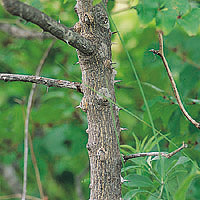Penn Herb Wellness Guide
Prickly AshFind Products
 © Martin Wall
© Martin WallHow It Works
Prickly ash bark contains alkaloids and a volatile oil. The fruit is rich in the volatile oil. Little research has been done specifically on the constituents or actions of American prickly ash. Preliminary Chinese trials have reportedly found that oral use of Chinese prickly ash berries can alleviate pain due to indigestion, gallbladder disease, or ulcers, as well as eliminating pinworms.6 Herculin, an alkamide in the plant, produces a localized numbing effect on the tongue when consumed.7 Whether this explains the historical use of prickly ash for toothaches remains to be confirmed in clinical trials.
How to Use It
A tea of prickly ash is made by simmering 12 teaspoons (510 grams) of the bark for 1015 minutes. Three cups (750 ml) per day are recommended.8 Alternatively, a tincture, 1/23/4 teaspoon (24 ml) three times per day, may also be used.9 Prickly ash is best taken just before meals. Traditionally, the bark was chewed to relieve tooth pain.10
Copyright 2025 TraceGains, Inc. All rights reserved.
Learn more about TraceGains, the company.
The information presented by TraceGains is for informational purposes only. It is based on scientific studies (human, animal, or in vitro), clinical experience, or traditional usage as cited in each article. The results reported may not necessarily occur in all individuals. Self-treatment is not recommended for life-threatening conditions that require medical treatment under a doctor's care. For many of the conditions discussed, treatment with prescription or over the counter medication is also available. Consult your doctor, practitioner, and/or pharmacist for any health problem and before using any supplements or before making any changes in prescribed medications. Information expires December 2025.


